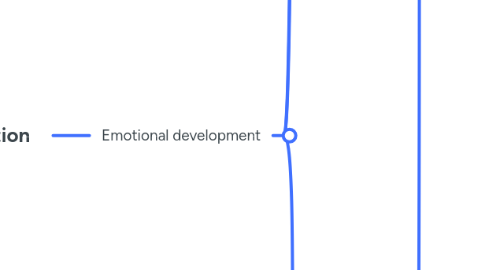
1. Emotional development
1.1. multifactorial
1.1.1. 1. How they arise
1.1.1.1. emotional reactivity
1.1.1.1.1. by external elements
1.1.1.1.2. emotional recognition
1.1.2. 2. Emotions as a reaction
1.1.2.1. related
1.1.2.1.1. emotional regulation
1.1.3. 3. Emotional expresions
1.1.3.1. related
1.1.3.1.1. emotional reactivity
1.1.3.2. emotional signs
1.1.3.2.1. Campos, 1983
1.1.3.2.2. Ortiz, 2001
1.1.3.2.3. Camras, 1994
1.1.4. 4. Emotional conscious
1.1.5. 5. Emotional autoregulation
1.1.5.1. impulses
1.1.5.2. group of strategies
1.1.5.3. Eisenberg, 1997
1.1.5.3.1. no autoregulation
1.2. social interactions
1.2.1. needed to have a good development, and viceversa
1.3. age range
1.3.1. first childhood
1.3.1.1. language comprehension
1.3.1.1.1. interpretation of emotions
1.3.1.2. emotions are the same for everyone
1.3.1.2.1. Darwin, 1872
1.3.1.2.2. Izar, 1982
1.3.1.2.3. Ortiz, 2001
1.3.1.2.4. Camras, 1944
1.3.1.3. affective emotions
1.3.1.3.1. social stimuli
1.3.1.3.2. caregiver bond
1.3.1.4. fear
1.3.1.4.1. 8 months
1.3.1.5. Emotions
1.3.1.5.1. actions
1.3.1.5.2. possessions
1.3.1.5.3. 18-24 months
1.3.1.6. Emotional comprehension
1.3.1.6.1. paral·lel to expression
1.3.1.6.2. maduration of
1.3.1.6.3. development
1.3.2. schooling to puberty
1.3.2.1. teachers evaluation
1.3.2.2. social comparison
1.3.2.3. new conflicts
1.3.2.4. apparition of
1.3.2.4.1. self-conscious emotions
1.3.2.4.2. self-efficacy
1.3.2.4.3. empathy
1.3.2.4.4. blame
1.3.2.4.5. sociomoral emotions
1.3.2.5. The I comprehension
1.3.2.5.1. formation of
1.3.2.6. emotional comprehension
1.3.2.6.1. new bonds
1.3.2.6.2. maintenance of socioaffective relations
1.3.2.6.3. means
1.3.2.7. emotional expression
1.3.2.7.1. marked by
1.3.2.7.2. autoregulation
1.3.3. puberty
1.3.3.1. consolidation of personality
1.3.3.2. new tensions
